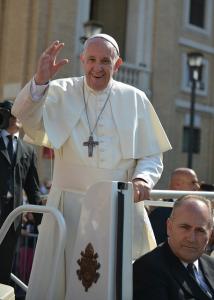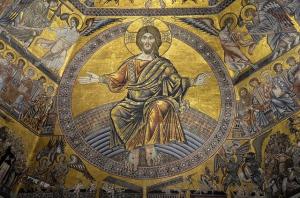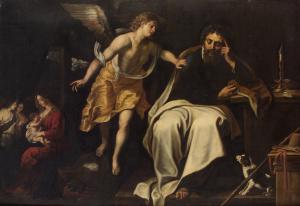In just under three weeks, an unofficial sort of season starts in the Church’s calendar for the Ordinariates. (1) (This is one of the ways that the Anglican Use (2) resembles the calendars of the East, alternating between fasting and feasting pretty regularly.)

The upcoming season, which begins on the day after Assumption and runs through the vigil of Michaelmas, is known as St Michael’s Lent. It doesn’t have official status—there are no special readings at Mass, and the liturgical color is still green—but it has some small weight of custom behind it, and it helps give variety to the long Trinity season. (3)
This semi-season apparently originates with St Francis, who observed the forty days between Assumption and Michaelmas as a time of fasting and prayer. He loved Our Lady, as we all know, but apparently he was pretty enthusiastic about St Michael as well.
Franciscan spirituality seems to have been specially influential in Mediæval England. It certainly produced great luminaries, including Roger Bacon, William of Ockham, and Bl John Duns Scotus, arguably the only Scholastic who could hold a candle to Aquinas. The spirit of cheerfulness, gentleness, and courtesy that animated Francis seems to have suited the English temperament better than the steely, almost rationalistic clarity of the Dominicans; you see something of the same sweet tranquility in Dame Julian. (That’s my pet theory, at least, which will likely be quite exploded in two years.)

Anyway, St Michael’s Lent follows the festivities of summer, and leads us right up to the feast of St Michael. Michaelmas in turn precedes quite a clutch of saints’ days in October, culminating in the ‘Hallowtide triduum’ of Halloween, All Hallows, and All Souls, which ushers in the very end of the liturgical year. It also incorporates three thematic holy days: the Passion of St John the Baptist on 29th August; the Exaltation of the Cross on 14th September; and the Ember week following the Exaltation. All of these accent the idea of the Christian carrying his own cross, penitentially and gloriously at the same time.
It isn’t meant to be as rigorous as Lent proper; e.g., if you go meatless throughout Lent, something like just meatless Wednesdays and Fridays (traditional fasting days) would be appropriate. Or adding something, like a Divine Mercy chaplet every evening.
I only started practicing St Michael’s Lent last year. I hadn’t heard of it before 2018: our pastor mentioned it in a sermon, recommending it. So I can’t say much about its benefits as a seasonal thing, not yet anyway. But fasting’s a good thing, and we don’t do much of it communally here in the West. So, if I may be so bold, give some thought to joining me in it this year. Justice for immigrants to the US, and reform of sexual and financial abuses in the clergy, are two excellent causes to devote prayer and penance to.
(1) The Ordinariates are a small collection of formerly Anglican churches who have been reconciled to the Catholic Church, but have maintained our own spiritual and ritual style. Pope Benedict XVI gave them official status in 2011; individual parishes and religious houses had been coming in under similar terms for decades. The Ordinariates are roughly equivalent to dioceses, defined by shared spiritual heritage more than by territory. There are three: Our Lady of Walsingham in the British Isles, Our Lady of the Southern Cross in the Pacific (mostly Australasia but also Japan), and Chair of Peter here in North America.
(2) Technically we’re supposed to say Divine Worship now instead of Anglican Use, but my counter-offer is that no one cares.
(3) The calendar of the Anglican Use does not employ Ordinary Time as in the Novus Ordo. Instead, the time following the octave of Pentecost, beginning with Trinity Sunday and running all the way to the end of the year, is known as Sundays in Trinity, or Trinitytide. The period between Epiphany and Ash Wednesday is mostly Epiphanytide, plus a brief preparatory period of two and a half weeks before the start of Lent, called Shrovetide. (Shrive is an obsolete word for ‘confess’—hence also the expression short shrift, meaning the rushed confession that might be given to a criminal before execution. Shrove was the past tense of shrive.)
Images via Pixabay












